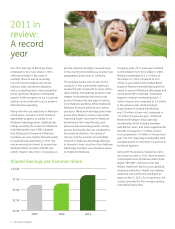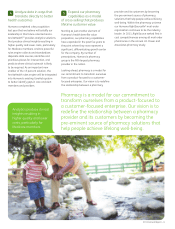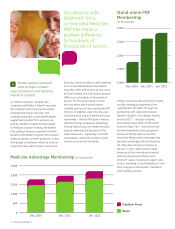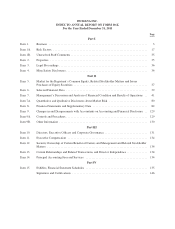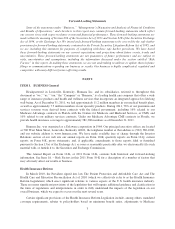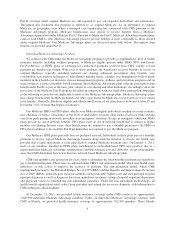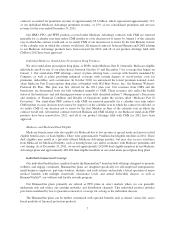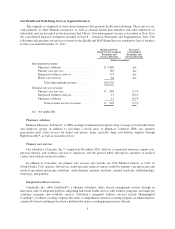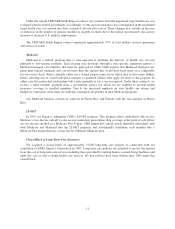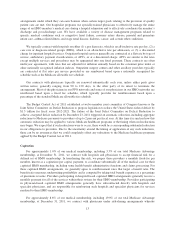Humana 2011 Annual Report Download - page 14
Download and view the complete annual report
Please find page 14 of the 2011 Humana annual report below. You can navigate through the pages in the report by either clicking on the pages listed below, or by using the keyword search tool below to find specific information within the annual report.Advantage premiums, the establishment of state-based exchanges coupled with programs designed to spread risk
among insurers, an annual insurance industry premium-based assessment, and a three-year commercial
reinsurance fee. Implementation dates of the Health Insurance Reform Legislation vary from September 30, 2010
to as late as 2018. The Health Insurance Reform Legislation is discussed more fully in Item 7. Management’s
Discussion and Analysis of Financial Condition and Results of Operations under the section titled “Health
Insurance Reform.”
2011 Business Segment Realignment
During the first quarter of 2011, we realigned our business segments to reflect our evolving business model.
As a result, we reassessed and changed our operating and reportable segments in the first quarter of 2011 to
reflect management’s view of the business and to align our external financial reporting with our new operating
and internal financial reporting model. Historical segment information has been retrospectively adjusted to reflect
the effect of this change. Our new reportable segments and the basis for determining those segments are
discussed below.
Business Segments
We currently manage our business with three reportable segments: Retail, Employer Group, and Health and
Well-Being Services. In addition, we include businesses that are not individually reportable because they do not
meet the quantitative thresholds required by generally accepted accounting principles in an Other Businesses
category. These segments are based on a combination of the type of health plan customer and adjacent businesses
centered on well-being solutions for our health plans and other customers, as described below. These segment
groupings are consistent with information used by our Chief Executive Officer to assess performance and
allocate resources.
The Retail segment consists of Medicare and commercial fully-insured medical and specialty health
insurance benefits, including dental, vision, and other supplemental health and financial protection products,
marketed directly to individuals. The Employer Group segment consists of Medicare and commercial fully-
insured medical and specialty health insurance benefits, including dental, vision, and other supplemental health
and financial protection products, as well as administrative services only products marketed to employer groups.
The Health and Well-Being Services segment includes services offered to our health plan members as well as to
third parties that promote health and wellness, including primary care, pharmacy, integrated wellness, and home
care services. The Other Businesses category consists of our Military services, primarily our TRICARE South
Region contract, Medicaid, and closed-block long-term care businesses as well as our contract with CMS to
administer the Limited Income Newly Eligible Transition program, or the LI-NET program.
The results of each segment are measured by income before income taxes. Transactions between reportable
segments consist of sales of services rendered by our Health and Well-Being Services segment, primarily
pharmacy and behavioral health services, to our Retail and Employer Group customers. Intersegment sales and
expenses are recorded at fair value and eliminated in consolidation. Members served by our segments often
utilize the same provider networks, enabling us in some instances to obtain more favorable contract terms with
providers. Our segments also share indirect costs and assets. As a result, the profitability of each segment is
interdependent. We allocate most operating expenses to our segments. Assets and certain corporate income and
expenses are not allocated to the segments, including the portion of investment income not supporting segment
operations, interest expense on corporate debt, and certain other corporate expenses. These items are managed at
the corporate level. These corporate amounts are reported separately from our reportable segments and included
with intersegment eliminations.
4


